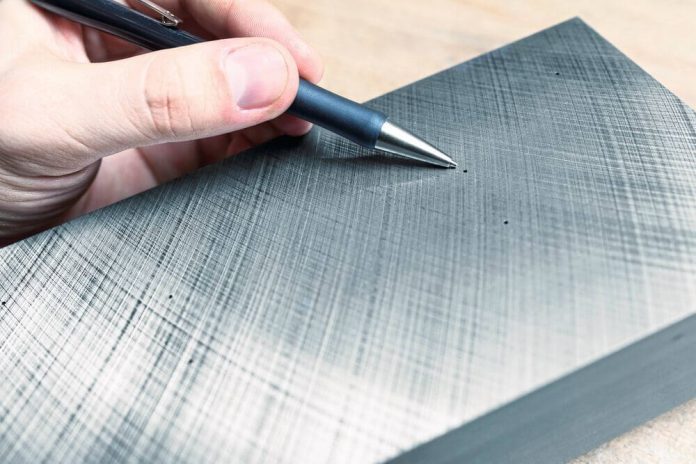To meet the different requirements for cutting steels used in die making, Meusburger has a large selection of NE blocks for eroding that cover a wide range of materials
The blocks for eroding are mainly used for the production of cutting punches and dies and are available from stock in heat-treated and hardened versions. Their thicknesses are perfectly matched to the plates of Meusburger’s standardised die sets.
General requirements for cutting steels
The hardness and wear resistance as well as the toughness are two of the most important criteria when selecting the appropriate cutting steel. Because these characteristics usually counteract each other, when choosing compromises often need to be made. This is usually done through working hardness or by a specific surface treatment. A comparison of cutting steels in terms of wear resistance and toughness is shown in the figure.
The selection of the cutting steel as well as its working hardness depends mainly on the thickness and strength of the material to be cut. The greater the thickness and strength of the strip material, the higher the loads on the active parts of the die. In the following, you will find an overview of the different types of cutting steel from the Meusburger range.

Source: Meusburger
Steel for through hardening
The material grade 1.2379 is considered the ‘classic’ steel in die making. This material is also used as a whole cutting die plate, as it has very good dimensional stability after hardening. Meusburger also offers NP precision bars made of this material. Generally, it is used for medium strength (up to approx. 400 N/mm²) strip material. The working hardness is approximately 60-62 HRC.
High-speed steel
The high-speed steel 1.3343 (HSS) is used as a standard material for dies and cutting elements. Compared to the material 1.2379 it has a higher wear resistance and hardness. It is used for medium strength (up to approx. 500 N/mm²) strip material and especially for thick sheets. The working hardness is approximately 63-65 HRC.
Powder metallurgy steel
Due to their homogeneous structure, powder metallurgical steels have a very high toughness.
The material grade 1.3344 PM (PM23) is used for dies and cutting punches with high loads. It is particularly used for strip material with strengths up to approximately 600 N/mm². The working hardness is approximately 63-65 HRC.
The powder metallurgical steel M V10 PM with 10 % vanadium is used for dies and punches with the highest loads. Due to the very homogeneous structure, it has excellent edge stability, even for components with complex geometries. The M V10 PM steel is ideally suited for strip materials with very high strengths (from approx. 800 N/mm²) and for materials that cause high abrasive wear (e.g. stainless steel). The working hardness is approximately 61-63 HRC.
The latest powder metallurgical steel at Meusburger is the material grade M W10 PM with about 10 % tungsten. This is used for dies and punches with maximum loads. In addition to very good edge stability, the material grade M W10 PM offers high compressive strength. It is used for strip material strengths from approximately 800 N/mm² and thicker sheets. It is ideally suited for materials that are susceptible to adhesive wear (e.g. aluminium, aluminium copper alloys, brass). The working hardness is approximately 66-68 HRC.
Carbide
The corrosion resistant universal carbide CF-H40S+ has excellent balance and offers the ideal compromise between hardness and fracture toughness with high edge stability. Ultimate wear resistance guarantees maximum service life of the die and punch. The metal is used for strip materials with highest strength.
For wire EDM, a starting hole is advantageous, since otherwise the EDM contour cannot be optimally determined and it leads to high wear if the wire is introduced from the side. At Meusburger, the NE blocks for eroding can therefore be configured and ordered with up to 10 customisable starting holes. The configuration is very easy in the Meusburger shops.

















































